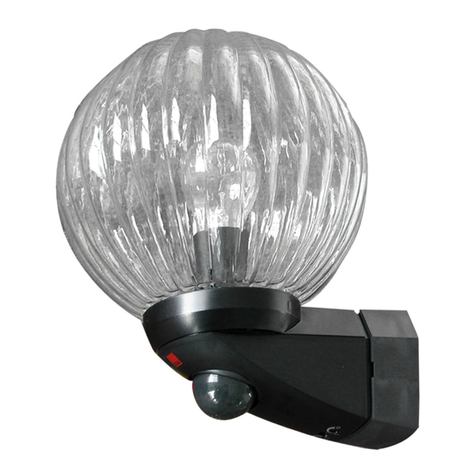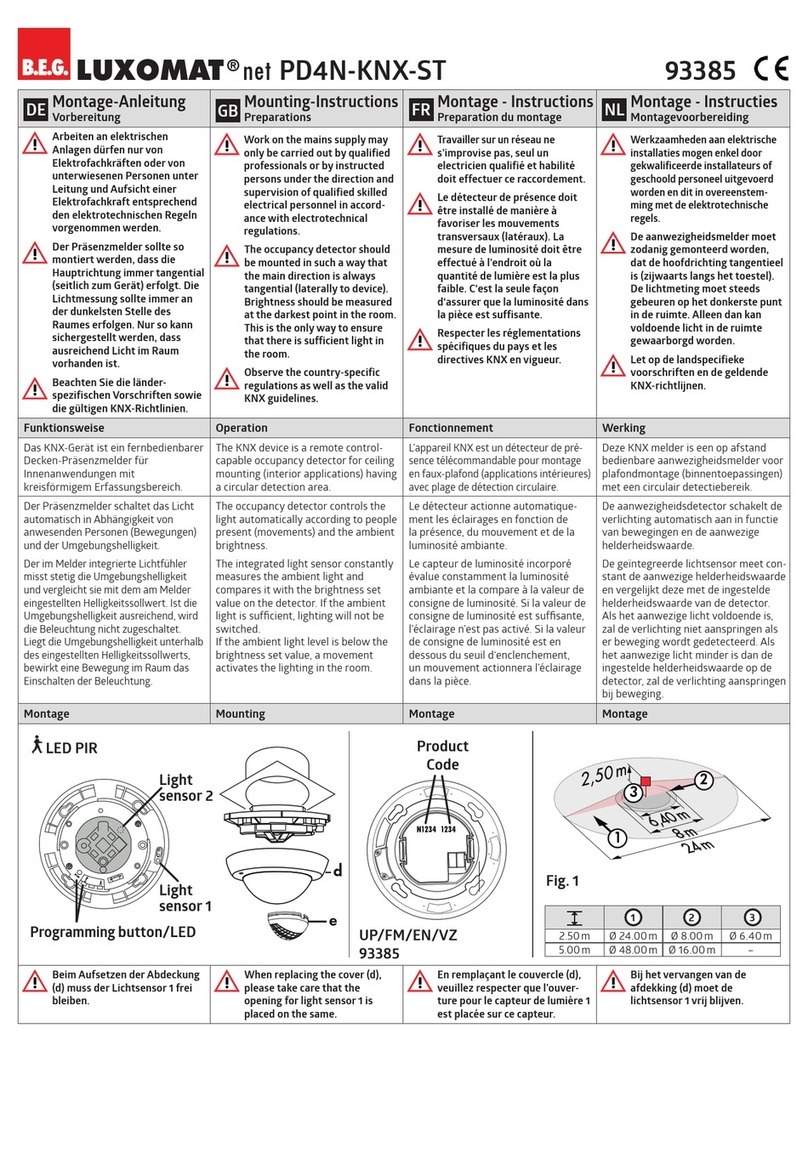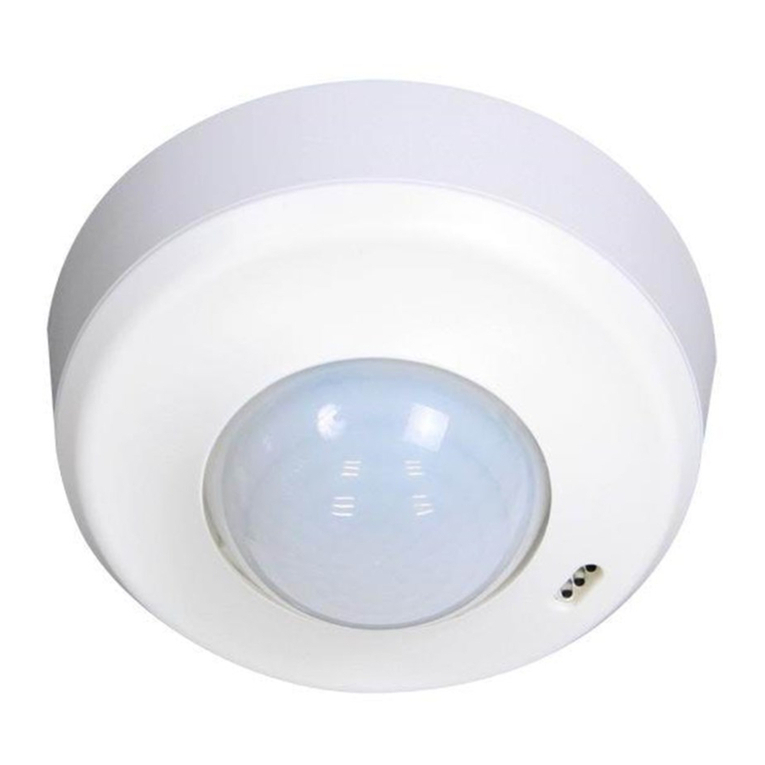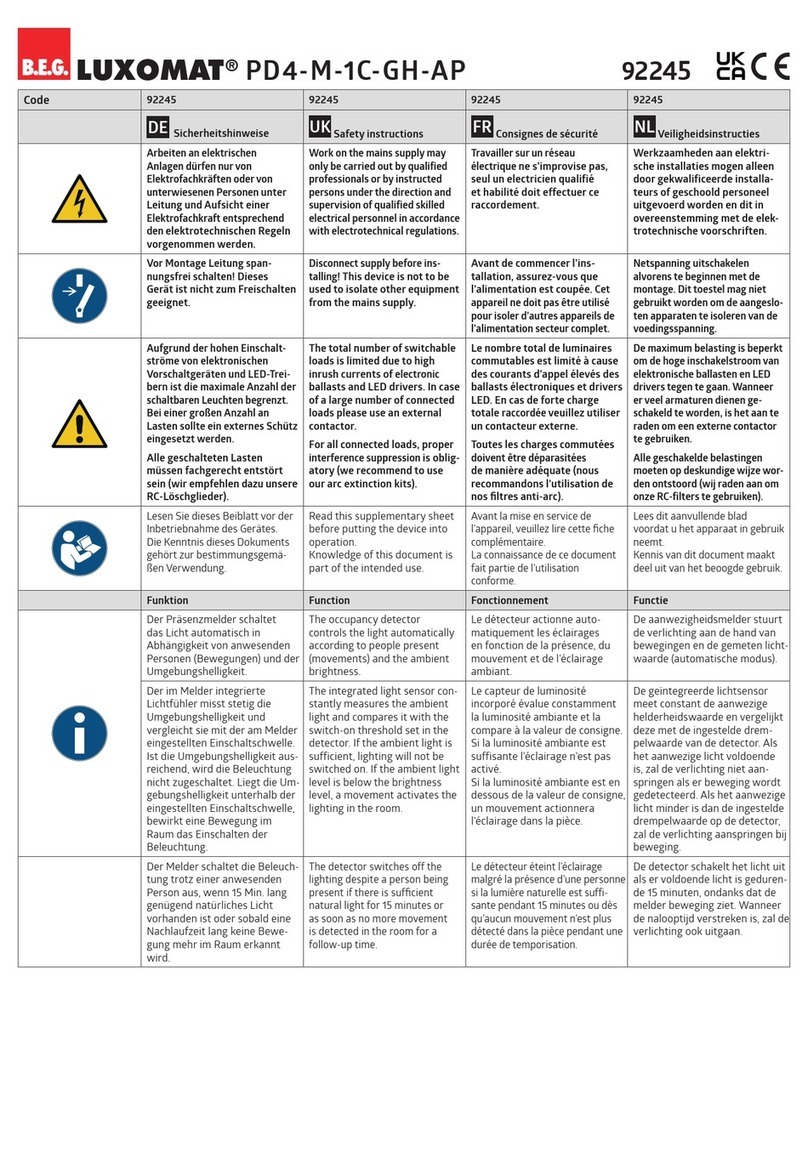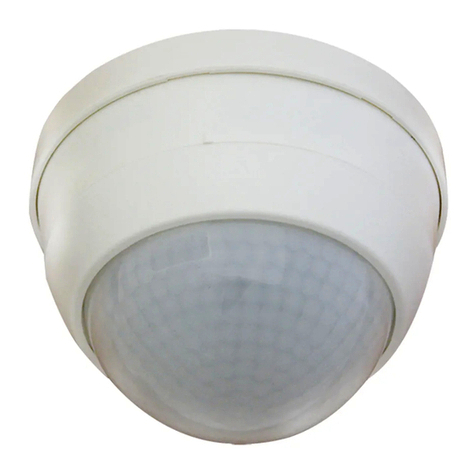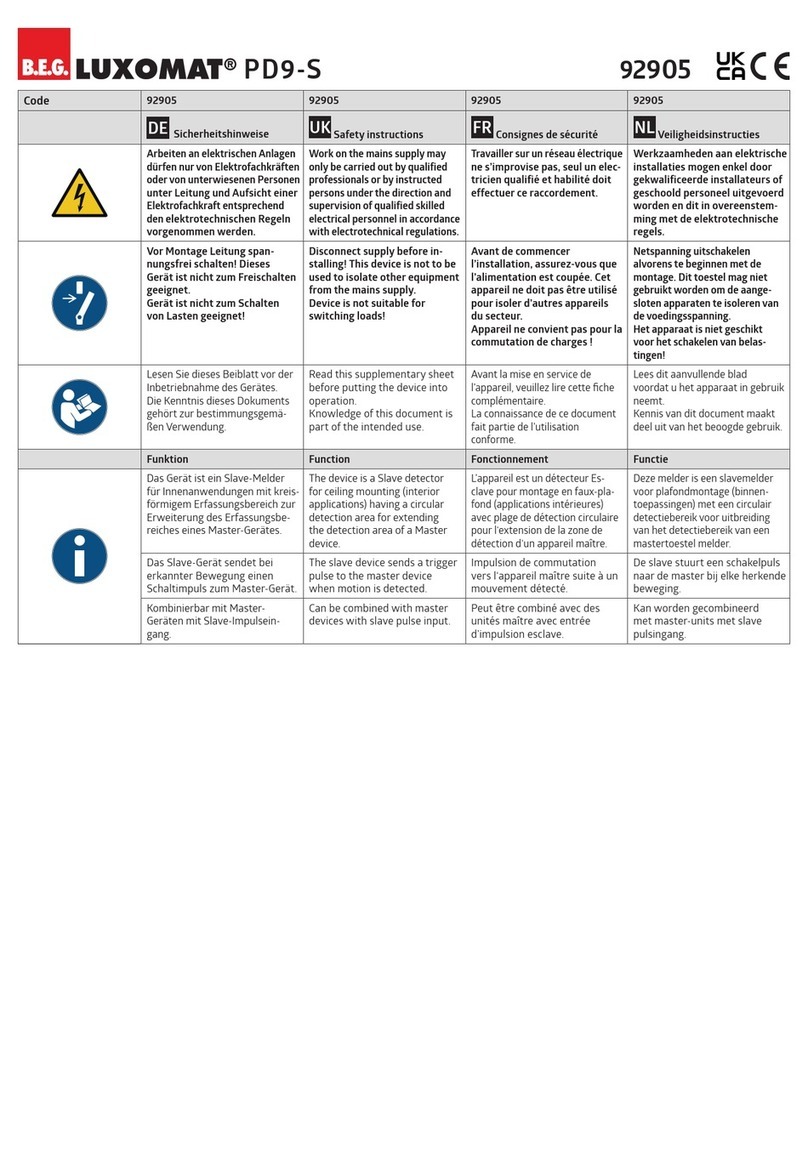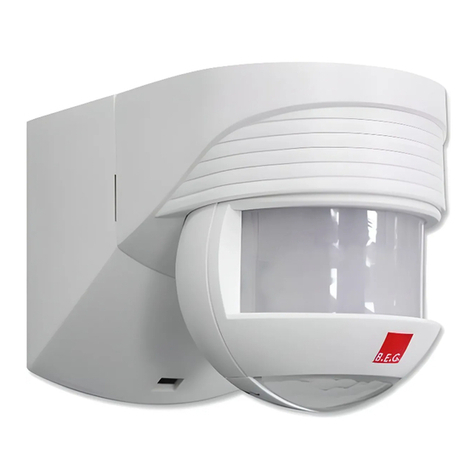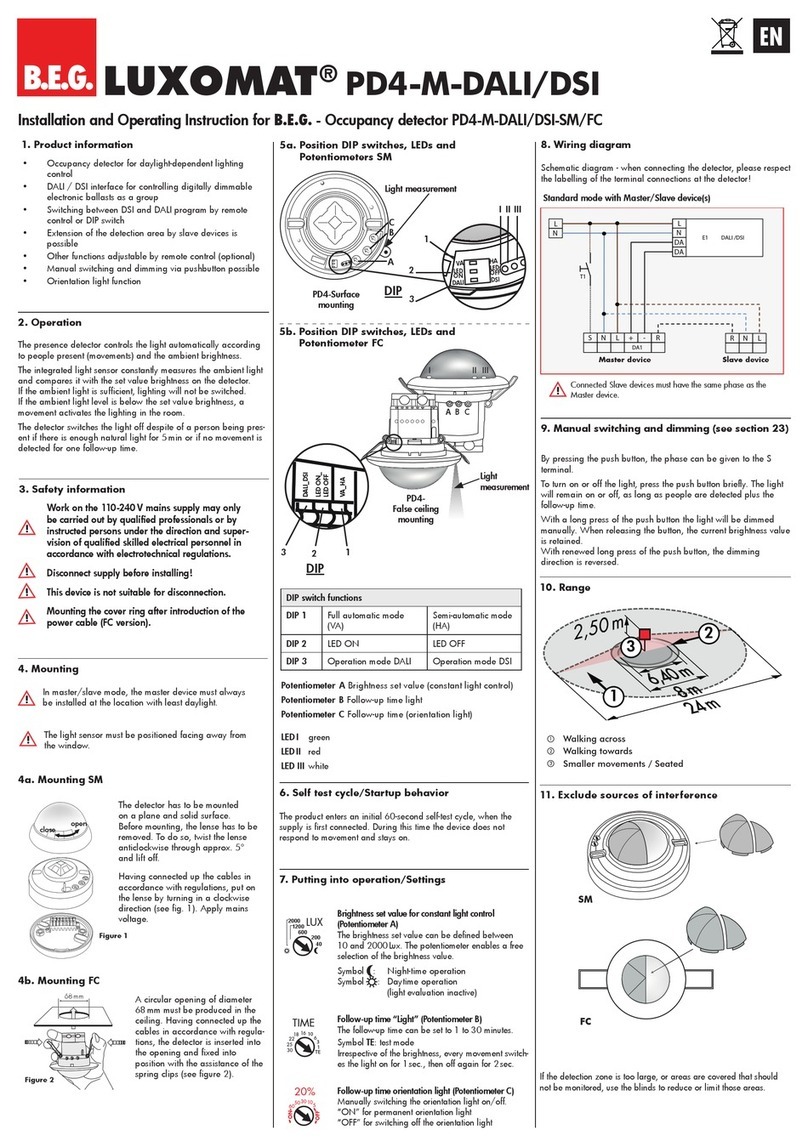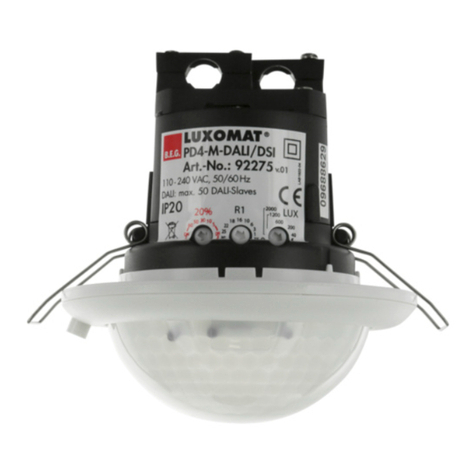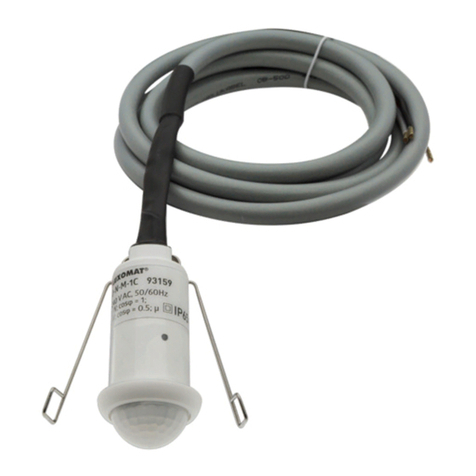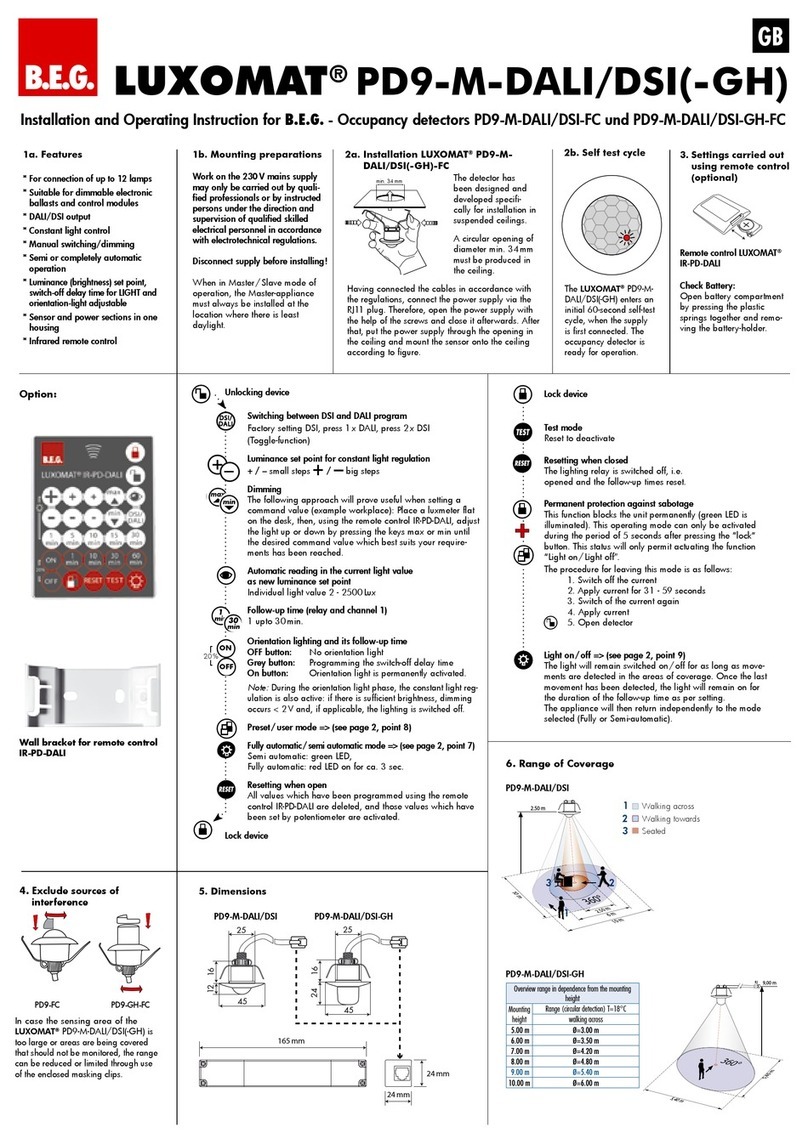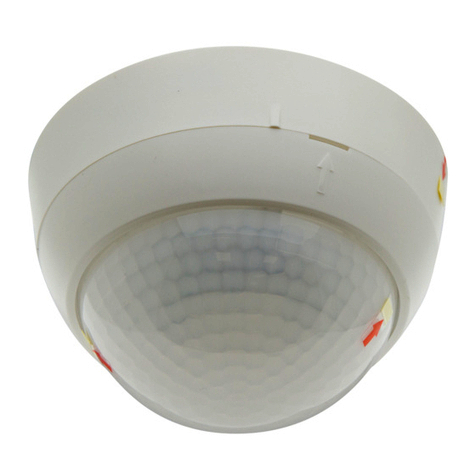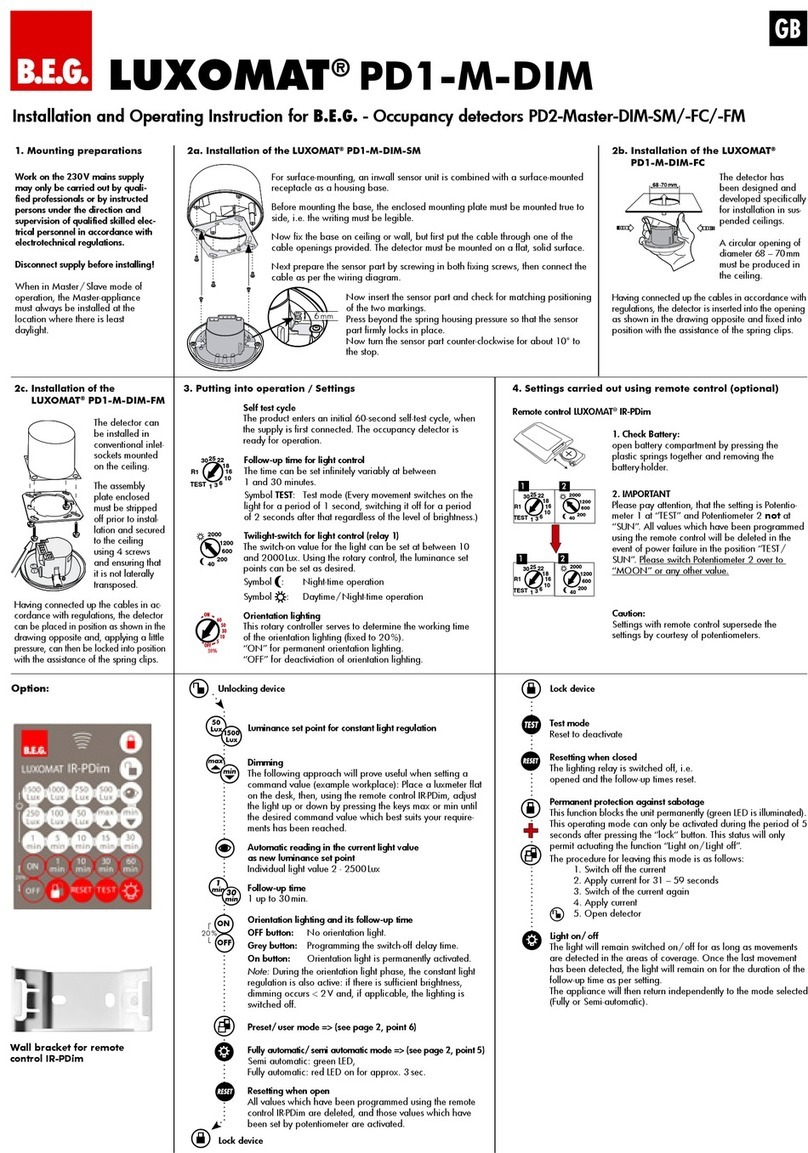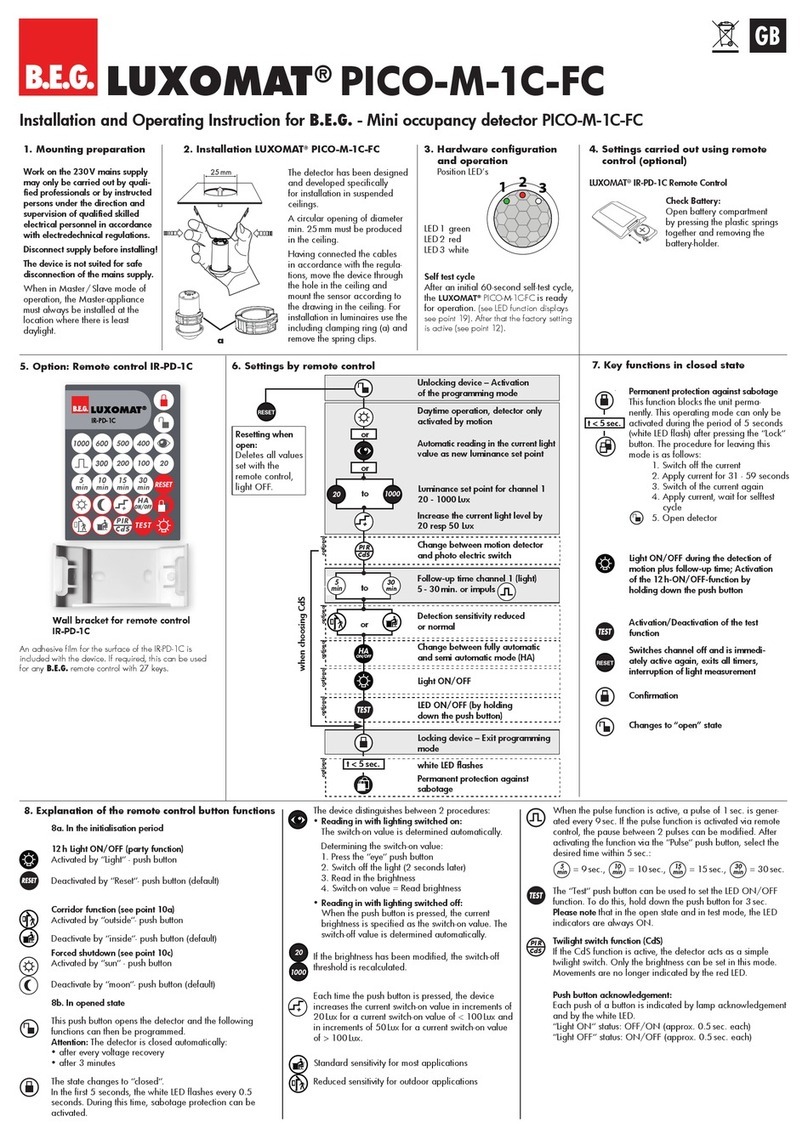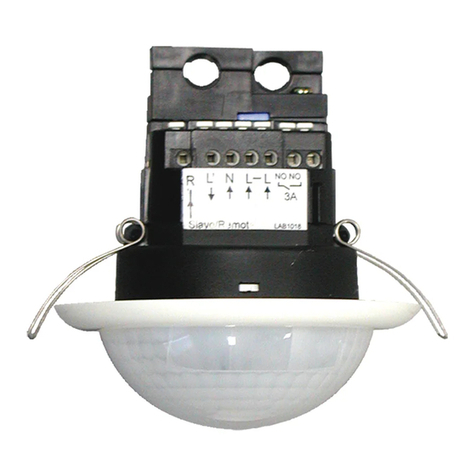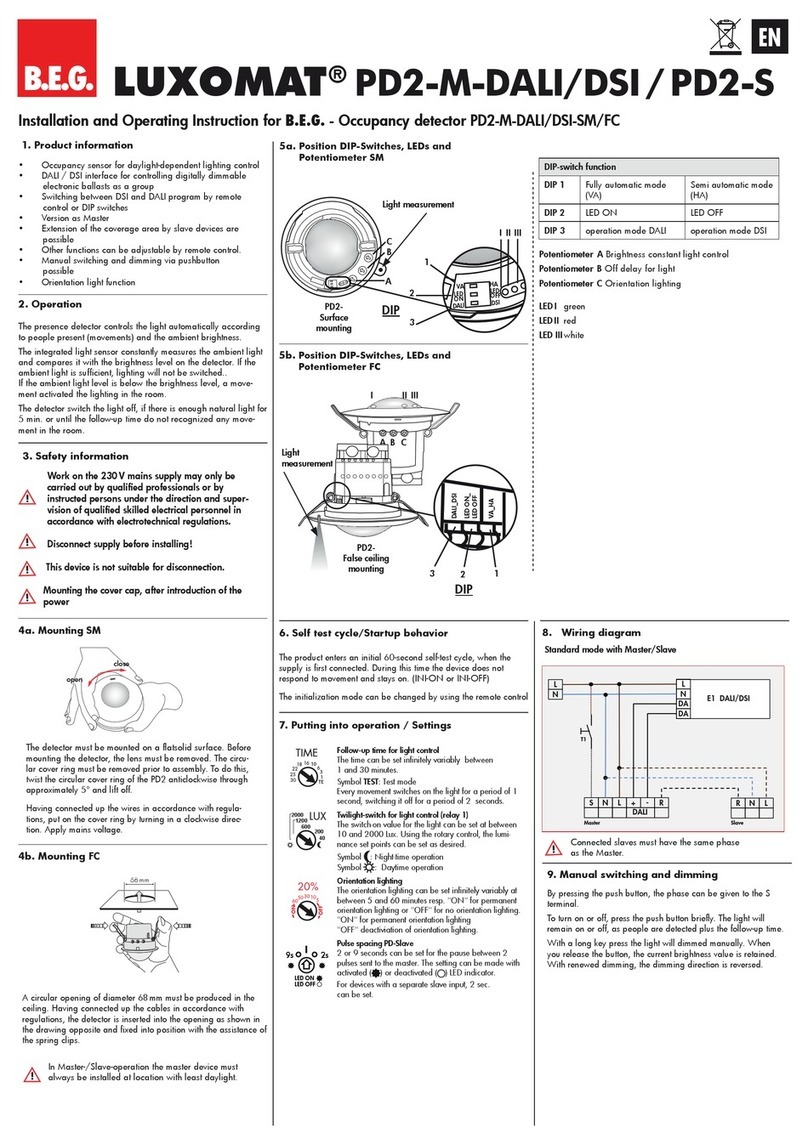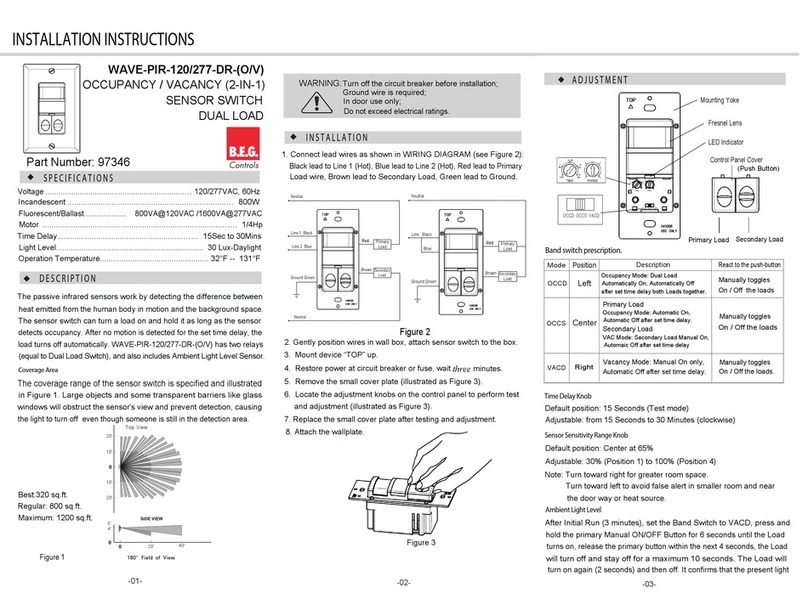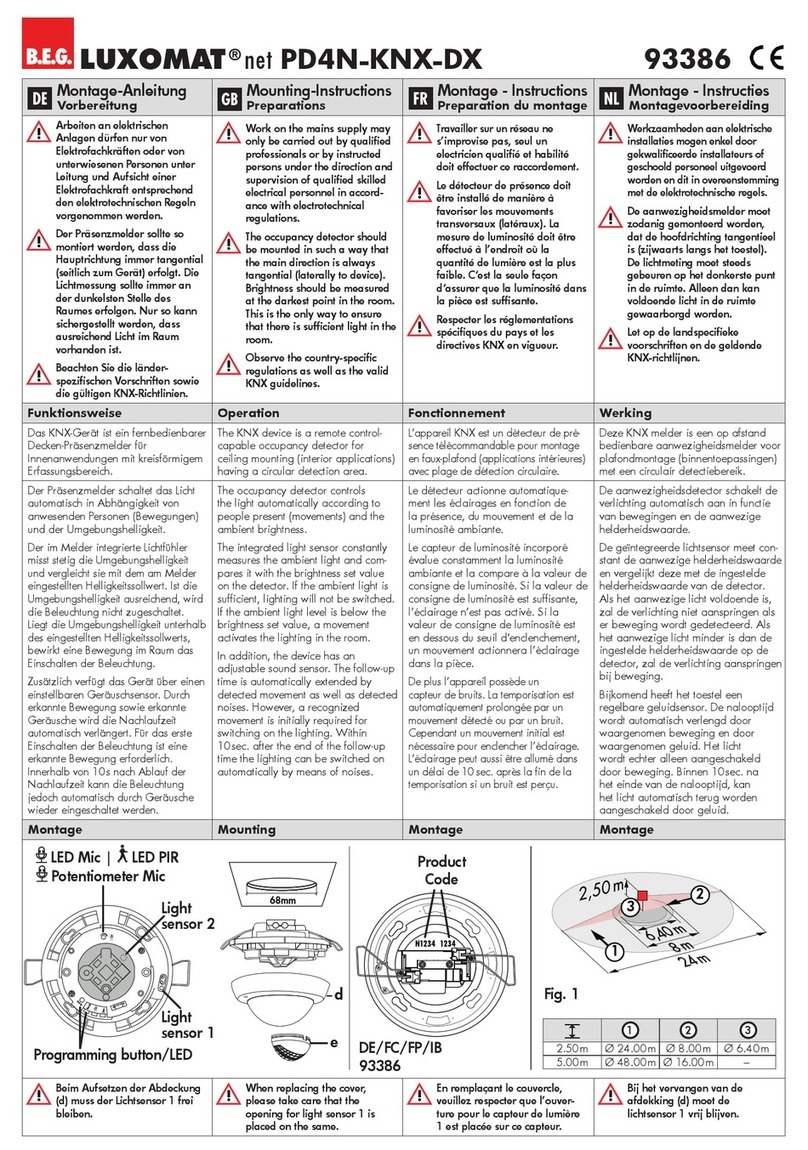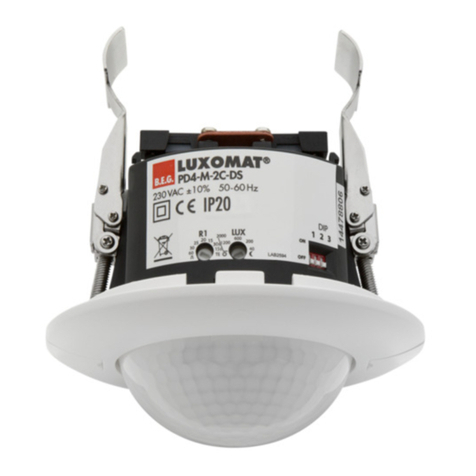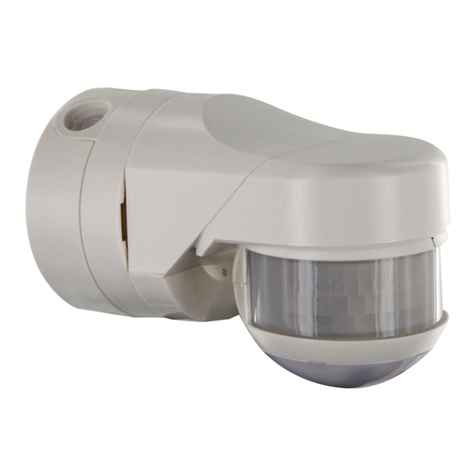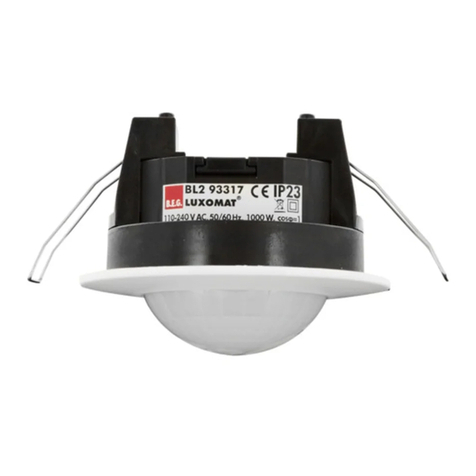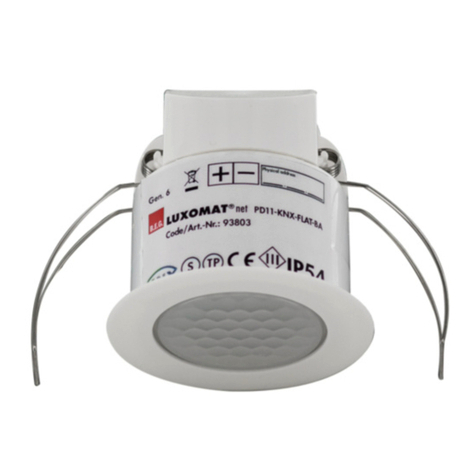
13. Full/Semi automatic mode
(see functions IR-PD-2C)
Fully automatic operation (presence)
In this operating mode, the lighting switches automati-
cally on and off for increased comfort, depending on
presence and brightness.
Semiautomatic operation (absence)
(semiautomatic can only be activated via the remote
control)
In this operating condition, in order to gain increased
savings, the lighting is energized only after being
manually switched on.
Switch-off takes place automatically.
In semi-automatic mode, switching-on must always be
carried manually.
As many (closer-contact) buttons as desired can be
wired in parallel on the “S” button input (ON/OFF).
14. Wiring diagram
15. Connections
PD4-M-2C new
M = HKL Funktion
optional
T1 = NO Taster für Halbautomatikbetrieb
Slave zur Erweiterung des Erfassungsbereichs
Master Slave
Übersicht
L
N
NOL´
LN
C1
N L
R
SNO
C2
T1 E1 M1
R
M1 = HVAC function
optional:
T1 = NO - Push button for semi automatic;
Extension of the detection area with Slave-
devices
The device distinguishes between 2 procedures:
• Reading in with lighting switched on:
The switch-on value is determined automatically.
Determining the switch-on value:
1. Press the “eye“ push button
2. Switch off the light (2 seconds later)
3. Read in the brightness
4. Switch-on value = Read brightness
• Reading in with lighting switched off:
When the push button is pressed, the current
brightness is specified as the switch-on value. The
switch-off value is determined automatically.
If the brightness has been modified, the switch-off
threshold is recalculated.
Each time the push button is pressed, the device
increases the current switch-on value in increments of
20 lux for a current switch-on value of < 100 lux and
in increments of 50 lux for a current switch-on value
of > 100 lux.
Standard sensitivity for most applications
Reduced sensitivity for outdoor applications
1000
20
+
9. Explanation of the remote control
button functions
9 a. In the initialisation period
12 h Light ON/OFF (party function)
Activated by “Light“ - push button
Deactivated by “Reset“- push button (default)
Corridor function (see point 11a)
Activated by “30 min“- push button – R2
Deactivate by “60 min“- push button – R2 (default)
Forced shutdown (see point 11c)
Activated by “impulse“ - push button – R2
Deactivate by “5min“- push button (default)
9 b. In opened state
This push button opens the detector and the following
functions can then be programmed.
Attention: The detector is closed automatically:
• after every voltage recovery
• after 3 minutes
The state changes to “closed“.
In the first 5 seconds, the white LED flashes every 0.5
seconds. During this time, sabotage protection can be
activated.
When the pulse function is active, a pulse of 1sec. is
generated every 9sec. If the pulse function is activated
via remote control, the pause between 2 pulses can be
modified. After activating the function via the “Pulse“
push button, select the desired time within 5sec.:
5
min = 9 sec.,
10
min = 10 sec.,
15
min = 15 sec.,
30
min =
30 sec.
The “Test“ push button can be used to set the LED ON/
OFF function. To do this, hold down the push button for
3 sec.
Please note that in the open state and in test mode, the
LED indicators are always ON.
Twilight switch function (CdS)
If the CdS function is active, the detector acts as a
simple twilight switch. Only the brightness can be set in
this mode. Movements are no longer indicated by the
red LED.
Push button acknowledgement:
Each push of a button is indicated by lamp acknowl-
edgement and by the white LED.
“Light ON“ status: OFF/ON (approx. 0.5sec. each)
“Light OFF“ status: ON/OFF (approx. 0.5sec. each)
Change between fully automatic and semi
automatic mode
PI R
CdS
1. If the switch-on threshold has been modified by the potentiometer
or remote control, the switch-off threshold stored in the EEPROM
is deleted and is then recalculated on the next activation.
Determining the switch-off value
1. Switch on for 5 min. with dark and motion
2. Light OFF for 2sec.
3. Internal calculation of the switch-off value
2. If the eye push button is pressed, the switch-off threshold is
recalculated. See also Remote control–> Eye section
3. Switch-off delay
If the determined switch-off threshold is exceeded during opera-
tion, the detector only switches off after a delay of approx.
15 minutes. This compensates for any brief fluctuations in the
brightness.
10. Switch-off threshold brightness
The “Corridor“ and “Light ON/OFF“ functions are mutually
exclusive. If both are activated, the detector performs the corridor
function.
The behaviour when the push button is pressed is defined as
follows:
Corridor function activated
Light ON:
Push button pressed briefly: Light OFF -> Active after 5 sec.
Push button held down: Light OFF -> Active after 5 sec.
Light OFF:
Push button pressed briefly: Light ON as long as motion + Lag time
Push button held down: Light ON as long as motion + Lag time
11a. Behaviour of external push button/IR “Light“
12 h Light ON/OFF activated
Light ON:
Push button pressed briefly: Light OFF -> Active after 5 sec.
Push button held down: 12h OFF
Light OFF:
Push button pressed briefly: Light ON as long as motion + Lag time
Push button held down: 12h ON
12 h Light ON/OFF deactivated
Light ON:
Push button pressed briefly: Light OFF as long as motion + Lag time
Push button held down: Light OFF as long as motion + Lag time
Light OFF:
Push button pressed briefly: Light ON as long as motion + Lag time
Push button held down: Light ON as long as motion + Lag time
11b. Behaviour of external push button/IR “Light“
Forced shutdown active
Light OFF:
Light OFF: Push button pressed briefly: Light ON for approx. 30min.,
then forced shutdown if the set brightness is still exceeded.
11c. Behaviour of external push button/IR
“Forced shutdown“
Activation of light for 12 h via mains interruption
1. Interrupt current
2. Apply current for 2 to 5sec.
3. Interrupt current again
4. Apply current
5. Detector is now ON for 12 h
Exiting sabotage
1. Interrupt current
2. Apply current for 30 to 60sec.
3. Interrupt current again
4. Apply current
5. Detector is in simple closed state
230 V AC permanently at the slave input
If 230 V AC is applied at the slave input for longer than 10 sec., the
light is switched on permanently. When the 230 V is removed, the
light is switched off and automatic mode is activated.
230 V AC for 1 - 3 sec. at push button connection S
If 230 V AC is applied for 1 - 3 sec. at push button connection
S, this is interpreted as a slave signal at slave connection R. This
ensures that the detector is compatible with previous versions.
12. Other functions
HKL
max.
3A
N
L‘
L
S
RSensor
OUT
IN
L
N
R
Slave M1
T1
E1
30
min
60
min
5
min
HA
ON/OFF
